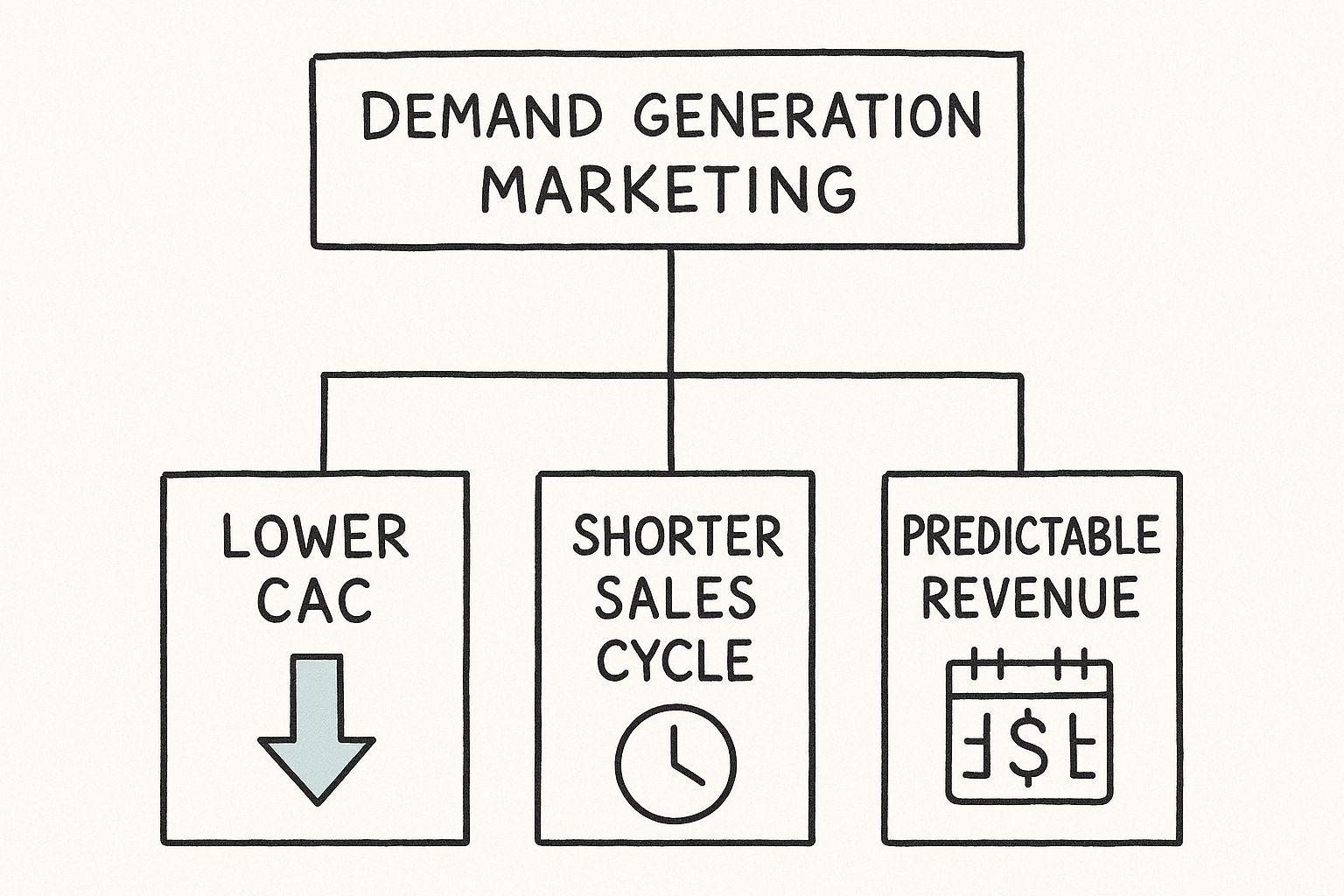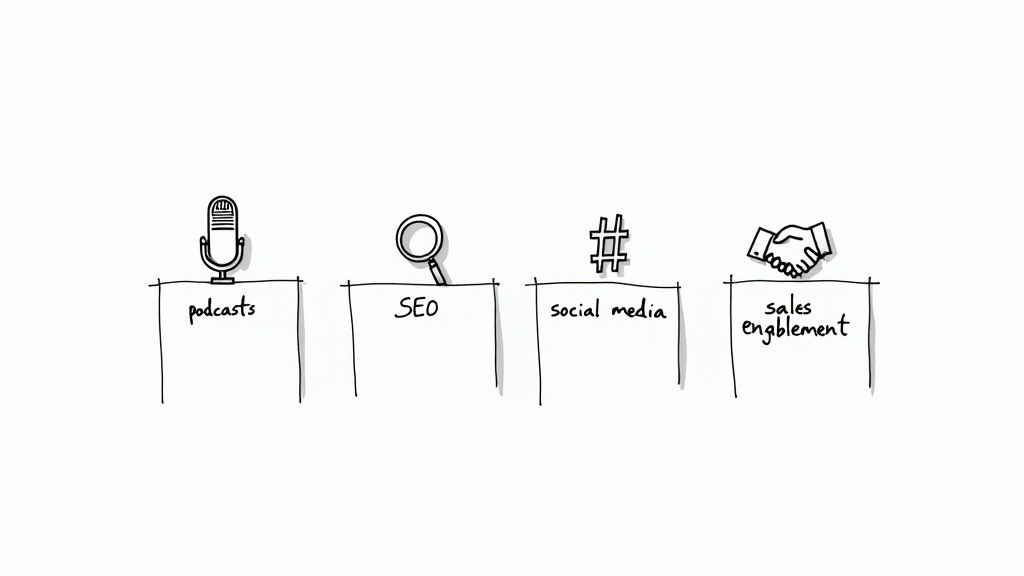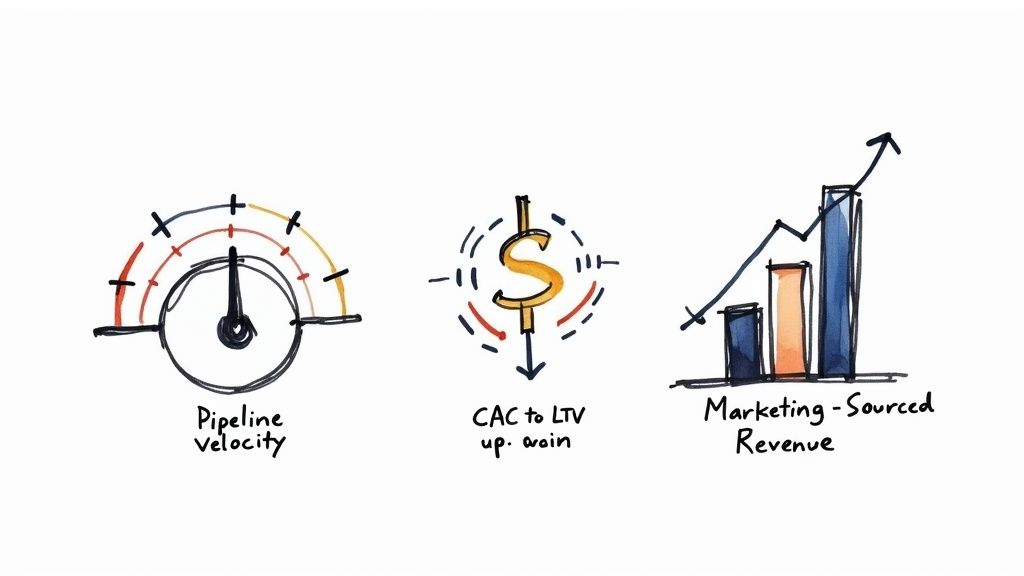What is Demand Generation Marketing? Your No-BS Guide to Real Growth
Forget chasing leads.
Demand generation marketing isn't about begging for attention. It’s about becoming the go-to authority in your industry so high-value customers find you. This is a full-funnel strategy designed to build awareness and real interest, creating a pipeline of educated buyers who trust you before a sales call ever happens.
Create Demand. Stop Chasing Leads.

Think of marketing like a party. Most marketers just spam invites (lead gen) and hope someone shows up.
Demand generation is different. You throw such a killer party that people are lining up outside, desperate to get in. You're not just sending invites; you're building a reputation as the only place to be.
This strategy flips the script from capturing contact info to creating authentic interest. Instead of dangling a flimsy PDF behind an email gate, you deliver massive value upfront—insightful articles, killer webinars, free tools—with no strings attached.
The goal? Make your brand synonymous with the problem you solve. When a potential customer faces their biggest challenge, your name should be the first one that hits them.
The Core Philosophy: Educate, Don't Sell
At its heart, what is demand generation marketing is a long-term investment in your audience. You educate your market and build unbreakable trust over time.
This approach acknowledges a hard truth: only a tiny fraction of your market is ready to buy right now. Some studies put that number as low as 3%. Demand generation is your plan for engaging and winning over the other 97%.
The strategy is built on a few core principles:
Educate, Don't Sell: Give away your best ideas. Position your brand as a trusted advisor, not a pushy salesperson.
Build Authority: Use original research and expert content to become the undisputed expert in your niche.
Create Brand Affinity: Build a brand people don't just recognize, but respect and want to follow.
Play the Long Game: Focus on building sustainable relationships that pay off for years, not just days.
Demand generation isn't a campaign; it's a fundamental shift in how you view the market. It’s about making your brand the obvious choice by the time a prospect is ready to buy.
This mindset is the key to sustainable growth. While capturing leads has its place, creating a consistent inbound flow of interested, educated buyers slashes sales cycles and drives down customer acquisition costs.
It's a crucial piece of a bigger puzzle. Understanding what is growth marketing helps put its importance into the larger context of scaling a business. Build a powerful brand presence, and your sales calls will start with, "I've been following your work for a while," instead of, "Who are you again?"
Why Demand Generation Is Your Growth Engine
For any startup trying to scale, demand generation isn’t just marketing fluff—it’s the engine. It’s the strategic bridge between a respected brand and real business goals. This is the shift that turns marketing from a cost center into a predictable revenue machine.
You're creating an environment where your ideal customers are pre-sold on your value long before they ever talk to sales. By consistently educating your entire market, not just the tiny fraction ready to buy, you build massive trust. When the time comes to solve their problem, you become the only choice.
This proactive approach makes every sales conversation smarter, crushes customer acquisition costs, and carves out a competitive advantage a single ad campaign could never touch.
From Unpredictable to Unstoppable
Relying only on capturing existing demand—people actively Googling a solution—is a reactive game. You're just fighting over scraps. Demand generation flips the script. It’s about proactively creating and nurturing interest across your entire potential market.
This builds a steady, predictable flow of well-informed prospects right into your pipeline. That consistency is the bedrock of scalable growth. Instead of riding the lead flow rollercoaster, you create a reliable system that keeps your sales team fed, month after month.
The real magic of demand generation is moving from a "hope and pray" growth model to a strategic, data-backed system that generates consistent revenue.
This predictability gives you the confidence to make smarter decisions—hiring reps, investing in product—because you know your marketing engine will deliver.
Shorten Sales Cycles and Lower Acquisition Costs
Imagine your sales team talking to a prospect who has already read your blog, listened to your podcast, and attended your webinars. The conversation is totally different. They aren't starting from zero. These people are educated on the problem and familiar with your solution.
This built-in trust and knowledge dramatically shortens the sales cycle. Instead of wasting weeks educating a cold lead, your team can jump straight to closing the deal.
This infographic shows how demand gen directly fuels core business metrics.

As you can see, the strategy is a direct line to lower Customer Acquisition Costs (CAC), shorter sales cycles, and the predictable revenue your business needs to thrive.
Building a Lasting Competitive Moat
In a crowded market, your best defense isn't a product feature—it's your brand's authority and the relationship you have with your audience. Demand generation is how you build that advantage.
When you become the go-to resource, you build a powerful "moat" around your business. Competitors can copy your product, but they can't replicate the trust you've earned with thousands of potential customers.
This long-term focus on value is why so many B2B brands are doubling down. The 2025 Demand Generation Benchmark Survey shows a clear trend: 35% of respondents are increasing their demand gen budgets. Even better, 28% expect revenue growth between 11% and 20%, directly tying their marketing to the bottom line. You can read the full demand generation survey results for more insights.
Ultimately, a strong demand gen strategy means you aren't just competing in the market—you're shaping it. You set the narrative, teach buyers what matters, and position your brand as the inevitable solution.
The Pillars of a Modern Demand Gen Strategy
A killer demand gen program isn't a one-off campaign. It's a machine built from interconnected parts. Think of it like a house: you need a solid foundation, strong walls, and a framework holding it all together.
A modern demand generation strategy relies on a few core pillars. Each has a specific job, from grabbing initial attention to helping your sales team close. Let's break down the blueprint.

Pillar 1: Top of Funnel Content Creation
This is where you plant your flag. Your goal isn't to sell—it's to educate, entertain, and solve problems for your audience before they even know they need you. This is how you build trust at scale.
This content must be genuinely valuable and completely free, positioning your brand as the go-to resource. Give away your best ideas to pull the right people into your orbit.
Formats that crush it at this stage:
Podcasts: Go deep on industry topics with expert guests. Build a loyal following that trusts what you have to say.
Original Research Reports: Run your own studies and publish the findings. This creates unique, data-backed content that others will cite, instantly boosting your authority.
Insightful Blog Posts: Forget generic fluff. Tackle your audience's biggest headaches with actionable articles that prove you know your stuff.
Free Tools and Templates: Give people something tangible they can use now. Think checklists, calculators, or templates that make their job easier.
The top of the funnel is all about generosity. Give away valuable insights with no strings attached, and you'll create an audience that’s ready to listen when you finally have something to sell.
This first pillar sets the stage for everything. Without a strong top-of-funnel game, the rest of your strategy crumbles.
Pillar 2: Mid Funnel Trust-Building Assets
Once you have their attention, it’s time to prove you’re the real deal. Here, you shift from broad education to specific problem-solving, showing how your approach works in the wild.
These assets nurture the interest you’ve sparked. They take prospects from, "I've heard of them," to, "I trust them to solve my problem." The content gets more detailed and solution-focused.
Effective mid-funnel assets include:
Webinars and Workshops: Host live sessions that teach a specific skill. This lets you interact directly with your audience and positions you as a hands-on expert.
In-depth Case Studies: Nothing builds trust like proof. Show exactly how you've helped similar companies get real, tangible results.
Ebooks and Whitepapers: Offer comprehensive guides that dive deeper than a blog post, providing a more structured learning path.
This focus on real-world results is critical. In fact, 57% of buyers chose case studies as their top content format—proof that people want to see results, not just hear promises. On top of that, 29% of marketing teams now use a fully integrated brand and demand approach, signaling a clear move towards cohesive, trust-building strategies. You can learn more and discover how marketing teams are evolving their strategies.
Pillar 3: Strategic Distribution and Amplification
Creating amazing content is half the battle. If nobody sees it, it doesn't exist. This pillar is about getting your valuable assets in front of your ideal audience where they already live. A great demand gen strategy is as much about distribution as it is about creation.
You need a smart mix of owned, earned, and paid channels working together to get the most bang for your buck.
Here’s your channel playbook:
Search Engine Optimization (SEO): This is non-negotiable. Optimize your content for the right keywords so people actively searching for solutions find you first. This is how you capture existing demand.
Social Media: Use platforms like LinkedIn or X (formerly Twitter) to share content, join conversations, and build a community. It’s your megaphone to the world.
Email Marketing: Nurture your audience with a newsletter that consistently delivers value straight to their inbox. This is one of your most powerful channels for building long-term relationships.
Sales Enablement: Don't forget, your sales team is a distribution channel. Arm them with the content they need to educate prospects, handle objections, and close deals. This directly connects marketing's efforts to revenue.
Your Actionable Demand Generation Framework
Knowing the theory is one thing. Building a demand gen system that actually works is another. A solid framework isn't a tangled mess of tactics; it’s a straightforward, repeatable process. This is your roadmap for turning ideas into a machine that generates real, consistent interest.
It all starts with one foundational question: Who are you really trying to reach? Without a crystal-clear answer, every other marketing effort is a shot in the dark. Let's build your foundation.
Step 1: Define Your Ideal Customer Profile
Before you write a single word or spend a dollar on ads, you must nail down your Ideal Customer Profile (ICP). This isn't a fluffy persona. It's a data-backed description of the exact type of company that gets insane value from your product.
Your ICP must be brutally specific. Dig into the details that matter.
Firmographics: What's their industry, company size, and annual revenue? Where are they located?
Technographics: What tools are in their tech stack? This is a huge clue about their maturity and where you fit.
Behavioral Traits: How do they buy? Do they trust peer recommendations, read industry reports, or need a sales call to pull the trigger?
Once you know the company, pinpoint the key people inside. Who holds the budget? Who feels the pain you solve every day? Getting this right sharpens your messaging and tells you where to show up.
Your ICP is your North Star. Every piece of content you create and every channel you choose should be laser-focused on them. If it doesn't resonate with this profile, it's a waste of time and money.
Step 2: Map Pain Points to Your Content Strategy
With your ICP locked in, get inside their head. What keeps them up at night? What are their biggest roadblocks and frustrations? This empathy is the fuel for a killer content strategy.
Your job is to create content that solves these specific pain points at every stage of their journey. Stop making content about your product; start making content about their problems. That’s how you become an expert advisor, not just another vendor.
Here's how to map it out:
Awareness Stage (Top of Funnel): Help them understand their problem better. Think "how-to" articles, original research, and podcasts that don't even mention your product.
Consideration Stage (Mid Funnel): Start introducing solutions. Host webinars, share in-depth case studies, and create comparison guides that help them weigh their options.
Decision Stage (Bottom of Funnel): Connect the dots directly to your solution. Demo videos, free trial walkthroughs, and clear pricing pages help them make the final call.
Step 3: Pick and Dominate Your Distribution Channels
Amazing content is useless if no one sees it. Distribution is just as important as creation. Instead of trying to be everywhere at once, find a few key channels where your ICP actually lives and focus on dominating them.
For example, if you're targeting e-commerce founders, platforms like X (formerly Twitter) or niche subreddits could be goldmines. A great visual product might win by developing a modern Pinterest strategy for growth to capture initial interest. The secret is to go deep, not wide.
Once you’ve picked your channels, automate your outreach and nurturing. For a closer look, check out our guide on building effective marketing automation workflows that save time and help you scale.
Step 4: Nail Down Attribution from Day One
Finally, you have to measure what’s working. Setting up clear attribution from day one is non-negotiable. You need to know which channels drive awareness, what content influences your pipeline, and how it all connects back to revenue.
Start with simple tracking like UTM parameters. As you grow, you can layer in more sophisticated multi-touch attribution models. This data is your secret weapon for optimizing your strategy and proving the massive value of demand generation to the rest of the company.
Measuring Demand Generation Success

Real demand generation isn't about chasing vanity metrics for a slide deck. It's about driving tangible business growth. Period.
Relying on old-school KPIs like Marketing Qualified Leads (MQLs) will mislead you. A high MQL count just means you’re good at getting people to fill out forms, not that you're creating real demand. It's time to shift focus from activity to outcomes.
Let’s reframe how we measure success. These metrics connect your efforts directly to the bottom line and prove your impact.
Move Beyond MQLs to Revenue Metrics
The MQL model creates a rift between marketing and sales. Marketing hits its quota with a flood of "leads," but sales quickly discovers most are garbage. This misalignment kills efficiency and morale.
Instead, rally both teams around metrics tied directly to the sales pipeline and closed-won deals.
These are the KPIs that actually matter:
Marketing-Sourced Revenue: The gold standard. This is the total revenue from deals that originated from marketing's efforts, proving a direct line from your activities to the company’s bank account.
Marketing-Influenced Revenue: This metric captures revenue from deals where marketing played a key role at any point in the sales cycle. It shows marketing’s broader impact on nurturing and accelerating opportunities.
The most powerful shift you can make is from measuring lead volume to measuring revenue contribution. It changes the conversation from "How many leads did we get?" to "How much business did we create?"
Tracking these revenue-focused metrics is fundamental. To nail this, you have to know how to calculate return on investment (ROI). This is the language executives speak.
Key Performance Indicators for Demand Gen
Beyond revenue, a few other metrics give you a clear view of your demand engine's health. Think of these as your diagnostic tools.
Pipeline Velocity This metric tells you how fast deals move through your sales funnel. Faster velocity means a shorter sales cycle and quicker cash flow. It’s calculated using the number of opportunities, average deal size, and your win rate over a set period.
Customer Acquisition Cost (CAC) to Lifetime Value (LTV) Ratio This is a critical indicator of business health. It compares what you spend to get a customer (CAC) with the total value they bring over time (LTV). A healthy ratio (typically 3:1 or higher) proves your marketing spend is generating profitable customers.
Tracking campaign attribution is a huge piece of this. Nearly 50% of marketers are actively measuring campaign performance, which is a great start. But the real insight is that only 2% of B2B organizations focused on broad, awareness-only content last year, moving instead toward more targeted, conversion-driven approaches.
A Practical Approach to Measurement
Starting to track these metrics doesn’t have to be a massive headache. The key is to establish a solid foundation and build from there. For a deeper dive, our guide on how to measure marketing ROI breaks it down with more actionable steps.
Here’s a simple table comparing the old way with the new:
Metric Type | Outdated Focus (Vanity Metrics) | Modern Focus (Revenue Impact) |
|---|---|---|
Top of Funnel | Website Traffic, Social Likes | Engaged Accounts, High-Value Sessions |
Mid Funnel | MQLs, Form Fills | Pipeline Created, Demo Requests |
Bottom Line | Cost Per Lead (CPL) | Marketing-Sourced Revenue, CAC:LTV |
By adopting this revenue-centric mindset, you transform marketing from a cost center into a proven growth driver. You'll make smarter strategic decisions and finally earn that influential seat at the table.
Common Demand Generation Mistakes to Avoid
The fastest way to get something right is to learn from everyone who got it wrong. A killer demand gen strategy can fall flat because of a few common, avoidable missteps.
Sidestep these landmines to keep your strategy on track and get results faster.
One of the biggest traps is treating demand generation like a short-term campaign. Teams throw money at a big push, see a temporary traffic bump, and then wonder why the pipeline is dry a month later. That approach is doomed.
Real demand gen is a long game. It's a marathon of building brand authority and earning trust. You need a steady, consistent drumbeat of valuable content and real engagement over months and years, not just a few weeks.
Siloing Marketing from Sales
This is the most destructive mistake you can make. Marketing runs in a vacuum, churning out content they think is brilliant, while sales complains the leads are garbage. It's a classic conflict that tanks growth.
When marketing and sales operate on different planets, you get a massive disconnect. If both teams don't agree on the Ideal Customer Profile (ICP), the messaging, and the goals, the whole system crumbles.
An effective demand generation engine requires unbreakable alignment between sales and marketing. Both teams must be rowing in the same direction, sharing intel, and using the same playbook to turn an audience into revenue.
This alignment ensures marketing’s work directly tees up sales conversations, turning your funnel into a well-oiled machine instead of a leaky bucket.
Creating Content Without a Distribution Plan
Here’s another classic blunder: spending countless hours on a masterpiece—a beautiful ebook, an insightful report—with zero plan to get it in front of the right eyeballs. Creation is only half the battle. Distribution is the other, equally critical half.
Great content that no one sees has an ROI of zero. A solid distribution plan isn't an afterthought; it must be baked into your strategy from day one.
Before you write, think about your channels:
Owned Media: How will you push this through your blog, email list, and social channels?
Earned Media: Who can you partner with? Think influencers or other publications that can share your work.
Paid Media: Can you use targeted ads on platforms like LinkedIn to amplify your best stuff and reach new corners of your market?
Generating Buzz Without a Capture Strategy
Finally, it’s a huge mistake to generate top-of-funnel buzz with no way to capture that interest. You might have a viral post or a hit podcast, but if there's no clear next step for someone to take, all that attention vanishes.
Your demand gen efforts must connect to a system that can spot high-intent behavior and guide people deeper. This means having clear calls-to-action, relevant mid-funnel content like webinars or case studies, and a handoff process for sales to jump on the hottest accounts.
Ultimately, understanding what is demand generation marketing means seeing it as a complete system. By dodging these common mistakes, you build a sustainable engine that drives predictable, long-term growth, not just temporary hype.
Ready to stop making mistakes and start building a predictable growth engine? At Viral Marketing Lab, we provide bootstrapped founders with the tools, templates, and actionable playbooks needed to accelerate growth. Explore our resources today and build a marketing strategy that delivers real results.










